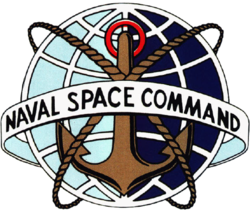Naval Space Command
| Naval Space Command | |
|---|---|
 |
|
| Active | 1 October 1983 – c. July 2002 |
| Country |
|
| Branch | |
| Role | NSC provides Operating surveillance, navigation, communication, environmental, Transportation and information systems |
| Part of | United States Space Command |
The Naval Space Command (NSC) was a military command of the United States Navy. It was headquartered at Dahlgren, Virginia (USA), and began operations 1 October 1983. Naval Space Command used the medium of space and its potential to provide essential information and capabilities to shore and afloat naval forces by a variety of means:
The command was merged into Naval Network and Space Operations Command, itself part of Naval Network Warfare Command, about July 2002.
Naval Space Command's headquarters staff and operational element numbers approximately 350 Navy military and civilian personnel. Their component commands include the Naval Satellite Operations Center and the Fleet Surveillance Support Command.
Naval Space Command, a component of USSPACECOM, operates assigned space systems to provide surveillance and warning, and provides spacecraft telemetry and on-orbit engineering support. In addition, Naval Space Command serves as the Alternate Space Control Center [AASC] for USSPACECOM's primary centers located at Cheyenne Mountain AS.
ASCC missions include operational direction of the entire global space surveillance network (SSN) for commander in chief, USSPACECOM (USCINCSPACE). The ASCC also detects, tracks, identifies, and catalogs all man-made objects in space and provides position information on these objects to about 1,000 customers. In addition, ASCC is charged with monitoring the space environment and informing owners and operators of U.S. and allied space systems of potential threats to their assets by continuous liaison with the systems' operations centers.
The heartbeat of Naval Space Command revolves around providing space support to day-to-day operations of the Fleet and Fleet Marine Forces worldwide, whether for routine deployments, exercises, or actions in response to a crisis situation. This space support to terrestrial and naval forces can be categorized across a broad spectrum of activities that encompass communications, surveillance and indication, and warning, intelligence, navigation, and remote sensing.
Naval Space Command manages two distinct surveillance efforts in support of U.S. Navy ships, other U.S. Navy units, and Fleet Marine Forces: tracking satellites in orbit and monitoring over-the-horizon threats from sea and air forces.
First, Naval Space Command operates a surveillance network of nine field stations located across the southern U.S. Three transmitter sites in the network are located at Jordan Lake, Ala., Lake Kickapoo, Texas, and Gila River, Ariz. Six receiver sites are located at Tattnall, Ga., Hawkinsville, Ga., Silver Lake, Miss., Red River, Ark., Elephant Butte, N.M., and San Diego, Calif.
...
Wikipedia
